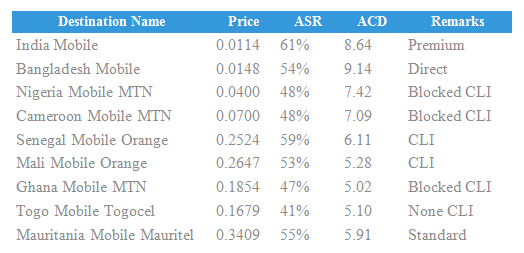When buying a traffic route, the price is only one of the important factors. Another one is quality. A good price but bad quality means a bad route and it is almost impossible to do continuous business with bad routes.
Sometimes it is feasible to use not-so-great quality routes, but it is safer to stick with good quality routes to keep your clients and make sure your business prospers.
When you buy a traffic route, you will see various quality descriptions. Quality can be seen in the price offer (often called the “push list”), which could look like this:
In this example route, the quality is under Remarks. As you can see, it can be called many different things.
There are many variations for how route quality is described. We will cover here most of the common ones.
Direct route
A direct route is when the route provider owns the termination equipment; they don’t rely on someone else. Most of the time, such a provider is a licensed long-distance international carrier (LDI). If you are not terminating traffic directly, this is the best option you can get. There are no intermediaries between you and your route provider and a call from your equipment goes directly to the provider’s equipment before reaching its final destination. The caller ID is sent without a problem and the call quality is superb. For direct interconnection with an LDI, you will need to satisfy some strict requirements (call volumes, credit history, etc.); the conditions vary.
CLI route
CLI means that the caller ID will be sent without problems. The recipient will receive it after it has been sent all the way through the chain of providers. The route will be tested by one of the providers. These routes are more expensive compared to non-CLI routes. It is important to note that real call quality, e.g., voice quality, can vary a lot. Being described as a CLI route does not indicate that the voice quality will be good.
Non-CLI route
No caller ID is passed to the recipient. This usually indicates that route is a so-called grey route, e.g., it is terminated using a GSM gateway or similar equipment, very often without the consent of the network owner. The caller ID sent to the recipient is very often random, e.g., it may be the caller ID over which the SIM card call was terminated. Be careful about using such a route. Often they are quite ok, but some inexperienced business owners use cheap equipment and have a poor internet connection, and you will end up with bad quality and lost clients. Sometimes non-CLI routes have exceptionally good voice quality due to the short chain of providers.
Premium route
Premium means that the voice quality is exceptional. The provider has taken care to make sure that the route has been tested and that voice sounds excellent. Take their word with a grain of salt. Test it yourself. Usually the caller ID is passed without problems with premium routes but again, your experience may be different.
Various
Many providers have their own way to mark the quality. If you are not sure, just ask them to clarify exactly what their description means. Examples include:
• Blocked CLI – This could mean that this is a grey route, like a non-CLI route. The caller ID is not sent, but instead some random caller ID or no caller ID is passed to the recipient. For example, it may be “unknown” or similar.
• TDM – This means that the route is terminated with time division multiplexing, such as a traditional phone service set up over a phone line. Very often the call quality is very good, almost the same as a direct route.
• Direct/CLI – This is just another way to emphasize how good the route is, plus the caller ID (CLI) is delivered.
• Standard – This can mean average voice quality. Sometimes the caller ID will be passed, sometimes not. To be safe, ask your provider.
Conclusion
It is important to remember that call quality is just a declarative property of the route and it can change based on many factors during usage.
Very often, providers try to be “smart” and during the testing period they give the agreed quality. But when the tests have been passed and real traffic begins, they mix 5–10% of not-so good quality traffic into the route. That way they increase their traffic margin significantly. It is up to the buyer to check the route quality using tools or services and to ensure that this does not impact its business.
The quality of the route is the most basic aspect for increasing traffic. Potential customers are always looking for good quality rather than a good price.


Dear sir,
we need a-z voip termination routes ( CC , Cli ) routes.
if you offer send us rates.
Best regards,
wcall
Hello,
We do not sell traffic.
Regards,
Mindaugas
Hello ,
this side sonam choudhary from Brain friendsltd.com
we are looking for Ncli routes (A to Z)
if you have contact me on skype -sonam@brainfriendsltd.com